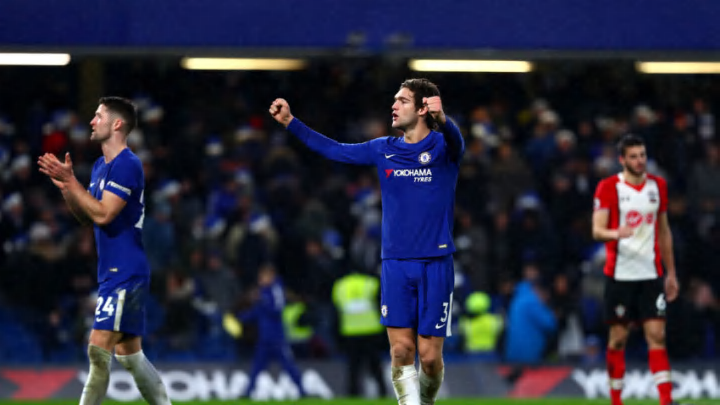If Antonio Conte has learned one thing in his time at Chelsea, it is that the transfer window rarely brings solutions to your problems. Antonio Rudiger and Danny Drinkwater may be the keys to a tactical alternative to playing Marcos Alonso every game.
Marcos Alonso started his 26th game in all competitions and went for the full 90 for the 22nd time in this campaign. Only Cesar Azpilicueta matches him among Chelsea’s outfield players. Azpilicueta rested for one Premier League game but started all six Champions League games, while Alonso rested the final Champions League match but has perfect attendance in the Premier League.
Antonio Conte needs a tactical alternative to starting Marcos Alonso as left wing-back. Conte is walking a tightrope with fatigue and injury by relying so heavily on Alonso. Even N’Golo Kante is showing the strain of fatigue, and Alonso is far more mortal (despite having hair spun by the gods).
Given Pedro’s and Davide Zappacosta’s poor showings at the position and Kenedy’s and Baba Rahman’s lack of readiness, Conte needs a formation without wing-backs. If Alonso cannot play in the Premier League or Champions League for whatever reason, Conte must have the Blues ready to dispense with wing-backs entirely.
Antonio Rudiger and Danny Drinkwater may be the players who enable Chelsea to succeed with a four-man defence. In Chelsea’s recent games Rudiger has shown the pace, dribbling ability and forward-looking nous they wanted when they signed him. Against weak and passive opposition throughout December, Rudiger could come off the back-three and play more as a left-back. Gary Cahill and Andreas Christensen were more than sufficient as the last man back, while Rudiger and Azpilicueta pushed high. Azpilicueta took his movement into the middle, while Rudiger played just inside the half spaces on the left.
Must Read: Chelsea must build on Stoke rout and continue winning with rotated squads
In Rudiger and Azpilicueta, the Blues have the two-way ability and – crucially – the speed they have not had among their full-backs in some time. They definitely did not have it in Antonio Conte’s first four-man defence with an aging Branislav Ivanovic. Azpilicueta will always play a bit more conservatively, even on the attack. Lately he plays deep to look for the diagonal cross to Alvaro Morata. Rudiger, on the other hand, has the speed to cover many of the same spaces as Alonso while being able to recover in transition.
Danny Drinkwater would cover the final 20% of Alonso’s territory and job description, as a freely-moving central attacking midfielder. Drinkwater showed against Stoke City his near Fabregas-ian ability to find passing lanes. Drinkwater covered a wide swath of territory in the centre of the pitch, and higher on the left. The Englishman would be the go-to for key passes, linking the rest of Chelsea’s play to the wingers and Alvaro Morata.
Drinkwater would also be the first line of defence when Chelsea turned over possession. His time as a central midfielder with N’Golo Kante at Leicester City showed his ability to control transitions in both directions. He would impede any attempts at a counter-attack, providing the first bit of cover to Kante and Tiemoue Bakayoko playing as centrally holding / defensive midfielders.

Drinkwater is Chelsea’s best option for this role. Bakayoko is at his best when he can anchor his play to Kante’s. Bakayoko can make the late runs, but is not comfortable playing forward while still having the full complement of defensive responsibilities. Cesc Fabregas does not have Drinkwater’s defensive skills or comfort covering the width of the pitch. Drinkwater has just enough of the transitional control of Nemanja Matic, the passing ability of Cesc Fabregas and the forward movement of a traditional central attacking midfielder to make this position work.
At its core, this formation would set up as a 4-2-3-1, although as with all Antonio Conte formations the “chameleon” would be in effect depending on the flow of play. Conte could play two wingers alongside Drinkwater in the “three.” That would put Chelsea in Conte’s preferred 4-2-4 / 4-2-1-3. Or he could play Cesc Fabregas as a deep-lying playmaker for a 4-3-2-1/ 4-3-3, or aligned with Drinkwater as he has been so far this season.

Antonio Rudiger gives Chelsea the freedom to play a four-man back-line. The Blues have various options to build atop that formation, but Danny Drinkwater opens the door to the most tactical creativity and the best balance between offence and defence.
Next: Wilfried Zaha could be an interesting transfer target for the Blues
Most importantly, Rudiger and Drinkwater can allow Marcos Alonso to take a day off. Antonio Conte can trust in his tactics much more than he can trust in the board’s activity in the coming month.
